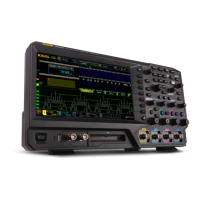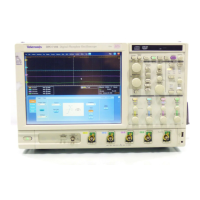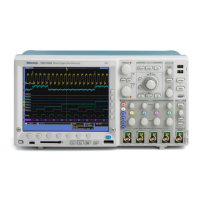Command Groups
ASCII will prod
uce more readable and more easily formatted output than that
produced by b inary format. However, ASCII may require more bytes to send the
same values than it does with binary. This may reduce transmission speeds.
Binary data can be represented by signed integer or floating-point values. The
defined binary formats specify the order in which the bytes are transferred. The
following are the four binary formats:
RIBinary specifies signed integer data-point repre sentation with the most
significant byte transferred fi rst.
SRIBinary is the same as RIBinary except that the byte order is reversed;
the least significant byte is transferred first. This format is useful when
transferring data to IBM-compatible PCs.
FPBinary specifies floating-point data-point representation with the most
significant byte transferred fi rst.
SFPBinary is the same as RFBinary except that the byte order is reversed;
the least significant byte is transferred first. This format is useful when
transferring data to IBM-compatible PCs.
Wavef
orm Data and Record
Lengths
You can transfer multiple points for each waveform record. You can transfer a
portion of the waveform or you can transfer the entire record. You can use the
DATa:STARt and DATa:STOP commands to specify t he first and last data points
of th
e waveform record. The instrument supports record lengths of 20, 50, 100,
250, 500, 1000, 2000, and 4000 samples.
Whe
n transferring data into the instrument, you must first specify the record
length of the destination waveform rec ord. To specify the record length, use
the WFMInpre:NR_Pt command. Next, specify the fi rst data point within the
waveform rec ord. For example, when you set DATa:STARt to 1 , data points will
be stored starting with the first point in the record. The instrument will ignore the
value set by DATa:STOP when reading in data. It will stop reading in data when
t
here is no more data to read, or when it has reached the specified record length.
When transferring data from the instrument, you must specify the first and last
data points in the waveform record. Setting DATa:STARt to 1 and DATa:STOP to
the record length will always return the entire waveform.
Waveform Data Locations
and Memory Allocation
The DATa:SOUrce and DATa:TIMebase commands specify the waveform source
and waveform timebase when transferring a waveform from the instrument. You
can only transfer one waveform at a time.
Waveforms sent to the instrument are always stored in o ne of the eight reference
memory locations. You use the DATa:DESTination c ommand to specify a
reference memory location.
2-46 DSA/CSA/TDS8X00/B Series Programmer Manual

